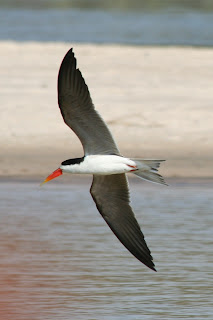Extending from the Taita Hills of Kenya south to the Udzungwa Mountains of southern Tanzania lies the endemic-rich Eastern Arc Mountains. Nicknamed the Galapagos of Africa, several of the ranges such as the Udzungwa, Uluguru and Usambara Mountains hold scores of endemics and some of the best birding in East Africa. Due to the lack of glaciations and relatively steady climate, the flora and fauna of these tropical forests had plenty of time to evolve becoming a very unique ecosystem.
After having to pass up the Udzungwa and Uluguru Mountains, I was eager to spend four days birding the East Usambara Mountains. Upon arriving back to the mainland, I met up with the owners of Emau Hill Forest Camp who offered to give me a lift to camp – a three hour journey up a terrible mountain road. Emau Hill offers a great base point for exploring Amani Nature Reserve and the rest of the Usamabaras.
 |
| Emau Hill Forest Camp |
The first three days were spent birding around camp and nearby trails; you don’t have to go very far to find great birds. On my first morning I woke to the loud calls of Silvery-cheeked Hornbills and Fischer’s Turacos – no need for an alarm clock! Leaving my tent I explored around the garden adding countless birds to my trip list – Olive and Uluguru Violet-backed Sunbirds, Montane White-eye, Southern Citril, Red-backed Manikin, Yellow-bellied Waxbill, Black-throated Wattle-eye and several species of Greenbuls mostly restricted to the Eastern Arcs. This place was phenomenal!
 |
| East Usambaras near Emau |
Day by day I was adding endless trip birds – Mountain and Gray Wagtails, Evergreen Forest-Warbler, Kenrick’s and Waller’s Starlings, Cabanis’s Bunting, Baglafecht Weaver, White-browed Barbet, Long-crested Eagle – my list was getting an enormous boost. The ultimate highlight though was an Usambara Eagle-Owl - one of the most difficult endemics – that I had early on the second morning calling from the opposite side of the valley.
Following a successful three days around camp I hitched a ride back down the mountain with one of the tour groups that were present during my stay. Obviously you don’t stop birding once you enter a vehicle so on our way down we were adding several more good birds including Yellow-rumped Tinkerbird, Mombasa Woodpecker, Red-tailed Rufous-Thrush, Red-capped Robin-Chat, Black-and-white Flycatcher, Little Yellow Flycatcher and the highlight of the day – Usambara Hyliota! This little known, minute, endemic is mainly recorded from the foothills of the East Usambaras. It is listed on the endangered list as its entire population is roughly 1,000 – 2,500 individuals, according to Birdlife International, and its habitat is disappearing at a rapid pace.
It was hard to leave what I would consider my favorite region of Africa yet, but there was still more birding to be done. After returning to civilization, I took a bus 8-9 hours to Arusha and settled down at a backpackers for the night.
About an hour north of town lie the Angyata Osugat Plains, east of the village Engikaret in the rain shadows of Mt. Kilimanjaro and Mt. Meru. These Massai lands are well-known for one of the rarest birds on the African continent – the Beesley’s Lark. A recent split from the more common Spike-heeled Lark, these birds number no more than 100 individuals. After a much needed goodnights rest, I headed north in search of these rarities. With tips from local birding legend, James Wolstencroft, I was able to find two Beesley’s after about three hours of searching! I can’t even explain the rush that went through me as I watched one of the rarest birds in Africa with Mt. Kilimanjaro in the distance. Other birds of note include Montague’s Harrier, Kori Bustard, Temminck’s Courser, Athi Short-toed Lark and Fischer’s Sparrowlark.
 |
| Angyata Osugat Plains |
 |
| Beesley's Lark |
Although nothing could come close to topping the Beesley’s, I continued birding the final hour of daylight in the nearby Acacia-commiphera woodlands. Being a new area I haven’t birded, I was able to pick up quite a few new birds including White-bellied Go-Away Bird, Von Der Decken’s Hornbill, Red-tailed Shrike, Superb and Hildebrandt’s Starlings, Beautiful Sunbird, Kenya Rufous Sparrow and White-bellied Canary. Before I knew it, it was dark and I headed back to Arusha.
 |
| Drive back to Arusha |
 |
| Mt. Kilimanjaro |
Unfortunately, this ended my last day of birding in Tanzania as it was time for me to start heading back south - I needed to be in Cape Town by December 10th (20 days away) and I still needed to travel through Malawi, Mozambique and across South Africa.














































